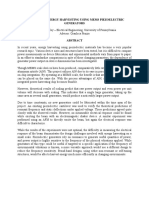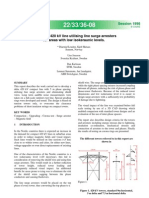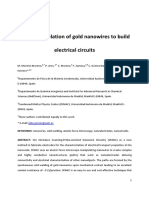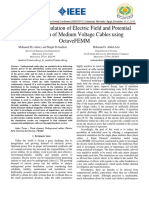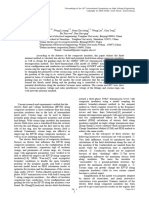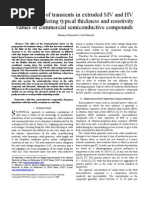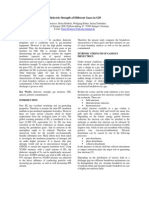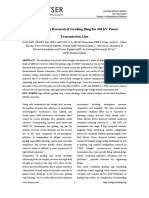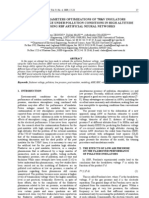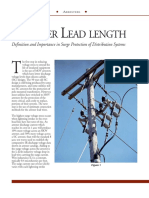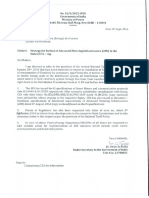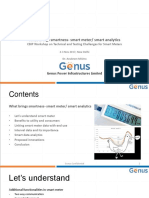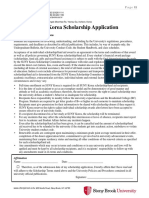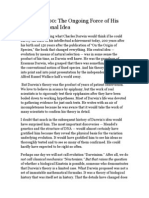Dielectric and Thermal Challenges For Next Generation Ring Main Units (Rmu)
Dielectric and Thermal Challenges For Next Generation Ring Main Units (Rmu)
Uploaded by
Shung Tak ChanCopyright:
Available Formats
Dielectric and Thermal Challenges For Next Generation Ring Main Units (Rmu)
Dielectric and Thermal Challenges For Next Generation Ring Main Units (Rmu)
Uploaded by
Shung Tak ChanOriginal Description:
Original Title
Copyright
Available Formats
Share this document
Did you find this document useful?
Is this content inappropriate?
Copyright:
Available Formats
Dielectric and Thermal Challenges For Next Generation Ring Main Units (Rmu)
Dielectric and Thermal Challenges For Next Generation Ring Main Units (Rmu)
Uploaded by
Shung Tak ChanCopyright:
Available Formats
CIRED 22nd International Conference on Electricity Distribution Stockholm, 10-13 June 2013
Paper 0463
DIELECTRIC AND THERMAL CHALLENGES FOR
NEXT GENERATION RING MAIN UNITS (RMU)
Tom Rune BJØRTUFT Elham ATTAR Magne SAXEGAARD
ABB – Norway ABB – Norway ABB – Norway
tom-rune.bjortuft@no.abb.com elham.attar@no.abb.com magne.saxegaard@no.abb.com
Adam SITKO Ole GRANHAUG Henrik LANDSVERK
ABB CRC – Poland ABB – Norway ABB – Norway
adam.sitko@pl.abb.com ole.granhaug@no.abb.com henrik.landsverk@no.abb.com
ABSTRACT INTRODUCTION
Environmental concerns related to the greenhouse effect of Environmental concerns related to the greenhouse effect of
SF6 have driven changes to take place in the power SF6 are promoting a new generation of power products
distribution industry. This paper discusses the main based on more environmentally friendly insulating gases.
challenges for next generation medium voltage (MV) ring In medium voltage network components such as the ring
main units (RMU) using new technologies and materials main units, SF6 serves both as an electrical insulator and a
with reduced environmental impact. Market requirements thermal conductor. Currently, no alternative gas has been
are going in the direction of equal or even higher technical found that exhibits the excellent dielectric and thermal
ratings for new products. Replacing SF6 with any other properties of SF6. Several gases have been explored, but
insulation gas in RMU requires innovative solutions to be many tend to suffer from high liquefaction temperature or
implemented. A key challenge is to be able to maintain the reduced dielectric strength (see e.g. [1]). From an
outer physical dimensions of the unit, as this imposes strict environmental perspective, dry air is one of the most
conditions on the dielectric and thermal performance. desirable alternatives.
Dielectric design of SF6 free RMU targets the distribution Market requirements are further going in the direction of
of electrical fields within the unit, aiming to reduce the field equal or even higher technical ratings for new products with
strength of weak points to compensate for the reduced the stringent requirement of no changes to the physical
dielectric strength of alternative insulating gases. Key dimensions of the unit. Optimizing the dielectric and
parameters for optimization include choice of insulating thermal design to comply with these requirements are
materials, geometrical shape of conducting surfaces and identified as the key challenges with the development of the
definition of conductor/insulator interfaces. Thermal design next generation RMU.
is further critical due to the lower thermal properties of
alternative insulating gases. Computational Fluid This paper summarizes the thermal and dielectric methods
Dynamics (CFD) analysis is used to understand and and possible solutions for achieving compact switchgear
optimize the temperature distributions inside the while maintaining the established ratings used in SF6-
switchgear. Simulation results are validated by temperature insulated RMU when replaced by dry air.
rise tests in full scale prototypes.
DIELECTRIC DESIGN
The main functionality of next generation RMU relies on
optimized dielectric and thermal design in order to provide In terms of dielectric performance, replacing SF6 with dry
a cost efficient and reliable unit. In this paper a selection of air in a ring main unit causes a drastic reduction in the
techniques are discussed with references to both withstand voltage level due to the reduced insulation level
simulations and full scale tests based on the challenging of dry air relative to SF6. The only possibility to compensate
boundary condition of keeping the same physical for this is to reduce the maximum electrostatic fields inside
dimensions as an existing SF6 product. the unit to a level below the critical limit for discharge. The
strict conditions of maintaining the physical dimensions of
the unit typically prevent simply increasing electrode
separation distances. Thus, careful optimization through a
combination of techniques is required.
CIRED2013 Session 1 Paper No 0463
CIRED 22nd International Conference on Electricity Distribution Stockholm, 10-13 June 2013
Paper 0463
The challenge may be appreciated by considering e.g. the As for streamer inception, streamer propagation is
withstand voltage of the disconnector in a 12 kV RMU. prevented by increasing the separation between the
Replacing SF6 bar with dry air at similar pressure causes the electrodes. Another option is to increase the effective
withstand voltage to drop with up to 50%. It follows that streamer path by inserting insulating barriers, but care must
while the type tested SF6 unit will pass the standard be taken to ensure that the charge transferred to the barrier
lightning impulse test (BIL) with good margins, the air by the first streamer does not create the condition for a
filled unit will fail if same design would be used. This second streamer on the other side of the barrier [3]
challenge must be resolved with careful optimization of the
dielectric design of the RMU. For the next generation RMU, the environmental impact and
carbon footprint can be seen to be lowered directly through
A general approach is given by considering the breakdown an optimization of dielectric design, as summarized in
mechanisms in gases. The inception of a self-propagating figure 1.
electron avalanche, known as a streamer is required for a
discharge to occur. In the limit of weakly non-uniform
fields and short electrode separation distances, the streamer
may cross immediately from one electrode to another and
create a discharge. The withstand voltage (Uw) is therefore Figure 1: Synergy of field uniformity with sustainability
given by the streamer inception voltage (Usi), which may be
determined from the “streamer criterion” [2]. However, for
larger electrode separation and strongly non-uniform fields, By utilizing the general design criteria described here,
the applied voltage must also be able to support the techniques such as shielding, barriers and “triple point”
propagation of the streamer across the gap. The critical evaluations are often the given solution on a specific design
voltage for streamer propagation (Uprop) has been challenge.
determined empirically for needle-plane arrangements in air
[3] and found to scale linearly with electrode separation.
Consequently, we may state the following “design rules”: Dielectric design example
An example of the application of these principles is the
a. For short electrode distances and weakly non- dielectric optimization of a typical 3-position disconnector-
uniform fields, Uw may only be increased by and earthing switch used in a 12 kV compact RMU.
increasing Usi Electrostatic simulations were performed with the ABB in-
b. At larger electrode distances and strongly non- house simulation tool Polopt that solves the Poisson
uniform fields, Uw may be increased further by equation with the indirect boundary element method [4].
increasing Uprop. The potential distribution and resulting electrostatic fields
of the disconnector are shown in figure 2.
The degree of field uniformity (η) is a key parameter. It is
typically defined as the ratio of the average electric field to The tip of the two knives is clearly identified as the critical
the maximum field observed between electrodes: points (dielectric “hot spots”), where the surface electric
fields are as high as ~ 10 kV/mm. Because of the short
η = Emean / Emax (1) distance to the ground electrode, Uw is estimated with Usi.
Emean is given by the voltage drop divided by electrode
separation distance. Turning this around, one can also see
that 1/η corresponds to the effective “field enhancement
factor”. It is clear that increased field uniformity is a driving
optimization criterion, as increased η tend to increase the
inception voltage and consequently the withstand voltage of
the electrode configuration.
In practice, η and Usi may be increased by reducing the
maximum electrostatic fields at the electrode surfaces.
Common methods for achieving this are:
- Increase the electrode separation.
- Reduce sharp features and edges Figure 2: Simulated potential and electric field distribution
- Increase radiuses of rounded surfaces of a 3-position disconnector and earthing switch in a 12 kV
- Limit the number of high field points, such as RMU. Color scale ranges from blue (minimum) to red
triple junctions (maximum).
CIRED2013 Session 1 Paper No 0463
CIRED 22nd International Conference on Electricity Distribution Stockholm, 10-13 June 2013
Paper 0463
A common solution to this design example is found by Decrease of heat losses by for example reducing number of
adding a field distributor to the tip of the knives, as outlined interfaces, right material selection, plating of contact
in figure 3. This increases the effective radius seen by the surfaces and increasing the conductor cross section or
voltage gradient and the maximum field strength is reduced decreasing the length of the conductor. Increase of the heat
by as much as 50%. Even though the separation distance dissipation by optimizing the design related to heat
between the high voltage knives and the ground electrode is convection, conduction and radiation inside and outside of
reduced, the condition for streamer inception is raised by the switchgear encapsulation. For these purposes parts,
approximately 160% due to the reduced surface field components and assemblies are arranged in such a way that
strength. This example demonstrates how a rather complex the natural free convection is optimized, by adding openings
geometry may be optimized with powerful tools as well as on the pole houses (figure 4) or increasing the free space
smart design criteria’s to find simple sustainable technical around all live parts (for an example using the slim support
solutions. brackets). In addition busbars are arranged somehow to
improve the effective surface.
To enhance the heat conduction dissipation, emphasize is
put on the choice of materials, optimization of dimensions
and reduced of the number of interfaces. For example, the
pole house cover is in particular made of a good heat
conductor, which is connected to the current path for
maximizing the effect of heat conduction. For optimizing
the radiation heat transfers the inner walls of the pole house
Figure 3: Schematic of the simulated field of the original do have a rough surface that is considered and utilized,
and modified disconnector switch knives together with possibility of painting or coating of inside as
well as outside encapsulation walls. All above mentioned
methods are considered for thermal design of the next
THERMAL DESIGN generation of RMU.
One of the main challenges of designing MV RMU is to
satisfy the requirements of the temperature rise test. In a CFD Simulation
standard temperature rise test as specified in IEC62271-1, The CFD simulation has been utilized for thermal design
the rated current at rated frequency in case of alternating optimization of next generation RMU filled with dry air.
current, is applied to the switchgear continuously, and the Most of the heat generated in the switchgear is accumulated
temperature of the components is measured separately until in the pole house. To increase the cooling of pole house, it
steady state conditions are reached. The steady-state is important that a good circulation of air is generated and
temperature rise in all of the components should be within maintained by introducing thoroughly dimensioned holes.
the permissible limits, as specified by the standard.
In order to improve the thermal performance of the
switchgear, first of all it is necessary to analyze it from a
thermodynamic point of view. The switchgear can be
considered as an enclosure with a series of elements
generating heat and able to dissipate heat to the
surroundings. The elements generating heat inside the
enclosure exchange heat between themselves or other
elements (conduction and radiation), with the gas inside the
enclosure (convection).
The structure of each element, its material and assembly
design inside the switchgear introduces a heat transfer
system which influences the temperature field. In particular,
the different arrangements of the assembly result in changes Figure 4: two different designs for free convection system
in heat generation pattern and consequently lead to new in a typical switch pole house that encloses a vacuum
temperature field equilibrium. interrupter (VI)
The main focus areas for RMU redesign are: decrease of the The position of the ventilation openings on the pole house is
ohmic heat losses and increase of the heat dissipation. important to enhance the “chimney” effect. The CFD model
CIRED2013 Session 1 Paper No 0463
CIRED 22nd International Conference on Electricity Distribution Stockholm, 10-13 June 2013
Paper 0463
has been used to compare two different designs of the empirical knowledge as well as a combination of
openings in the pole house (figure 4). Design A is technologies. Through examples of dielectric optimization
considered with one free convection system with openings and thermal design, it has been shown that the next
on top and bottom and design B with two separate free generation RMU can obtain the compactness of current SF6
convection systems with openings in the mid height as well filled units. This compactness is also utilized in a broader
as openings on top and bottom. perspective, by using a combination of materials as well as
the more environmental friendly insulation gas dry air to
Using design B with openings in the middle results in lower correspond to the overall sustainability approach.
gas velocity in the pole house (figures 5). From the
simulation results it can be concluded that any openings at
mid height can reduce the “chimney” effect, thus causing a REFERENCES
reduction of the buoyancy movement
[1] H. Okubo, A. Beroual, 2011, “Recent trend and future
Design A Design B perspectives in electrical insulation techniques …”, IEEE
Electrical Insulation Magazine. Vol 27, 34-42
[2] A. Blaszczyk, H. Boehme, A. Pedersen, M. Piemontesi,
2001, “Simulation based sparkover prediction in the
medium voltage range,” ISH Bangalore
[3] A. Pedersen, T. Christen, A. Blaszczyk, H. Boehme,
2009, “Streamer inception and propagation models for
designing air insulated power devices”, Proceedings IEE
Conference on electrical insulation and dielectric
Figure 5: Velocity fields for two different designs show a phenomena
better “chimney” effect in design A
[4 ] Z. Andjelic, B. Krstajic, S. Milojkovic, A. Blaszczyk
The full scale simulation of the whole RMU has been 1992, “Integral methods for the calculation of electric
performed by using Ansys Fluent commercial code with two fields” Scientific Series of the International Bureau
different designs, the original design and the modified Research Center Juelich (ISBN 3-89336-084-0)
design. Physical phenomena such as heat generation, heat
conduction, convection, radiation and turbulence were taken
into account.
The main differences between the original and modified
design were using silver platted bus bars with enlarged cross
section and thicker flexible connectors in modified case.
According to the simulation results, these two designs led to
two different temperature distributions with hot spots in
different positions. In the original design hot spots appeared
at flexible - bus bar connection and in the modified design
hot spots were on the knives. The numerically predicted hot
spots are similar to the experiment results obtained from
temperature rise tests for the original and the modified
designs. It was also proven that applying parts and
connections with lower resistances may significantly
decrease temperatures for the modified design.
CONCLUSION
The dielectric and thermal challenges associated with
replacing SF6 as an insulating medium with other, more
environmentally friendly gases can be solved with careful
optimization based on powerful simulations tool, deep
CIRED2013 Session 1 Paper No 0463
You might also like
- Step /1/: The Seven Steps That Save LivesDocument2 pagesStep /1/: The Seven Steps That Save LivesShung Tak Chan100% (2)
- Automated Broad and Narrow Band Impedance Matching for RF and Microwave CircuitsFrom EverandAutomated Broad and Narrow Band Impedance Matching for RF and Microwave CircuitsNo ratings yet
- Conductivity Modulation PDFDocument55 pagesConductivity Modulation PDFAkhilesh SinghNo ratings yet
- It Is Quite Another Electricity: Transmitting by One Wire and Without GroundingFrom EverandIt Is Quite Another Electricity: Transmitting by One Wire and Without GroundingRating: 4.5 out of 5 stars4.5/5 (2)
- New Ccba Sample Questions PDFDocument2 pagesNew Ccba Sample Questions PDFcvictoriaNo ratings yet
- Isobaric ProcessDocument24 pagesIsobaric ProcessBrando_Balagon75% (4)
- GM Diversity and InclusionDocument20 pagesGM Diversity and Inclusionsougata100% (1)
- Electrostatic Stress Analysis of High Voltage CablesDocument4 pagesElectrostatic Stress Analysis of High Voltage CablesesatjournalsNo ratings yet
- Townley Andrew 09Document17 pagesTownley Andrew 09Luis Gustavo ReisNo ratings yet
- Electric Field and Voltage Distribution Along Non-Ceramic Insulators PDFDocument16 pagesElectric Field and Voltage Distribution Along Non-Ceramic Insulators PDFostojic007No ratings yet
- Energies 12 03075 PDFDocument14 pagesEnergies 12 03075 PDFBat-ErdeneeeeeNo ratings yet
- Points To Consider Regarding The Insulation Coordination of GIS Substations With Cable Connections To Overhead LinesDocument5 pagesPoints To Consider Regarding The Insulation Coordination of GIS Substations With Cable Connections To Overhead Linesmoh_essamoNo ratings yet
- 1998 Paris Cigre 22 308aDocument9 pages1998 Paris Cigre 22 308amcel_2aNo ratings yet
- Cables Theory DesignDocument25 pagesCables Theory DesignA. HassanNo ratings yet
- Research On The Electric Field Controlling For The Arc-Chute of High Voltage SF Circuit BreakerDocument4 pagesResearch On The Electric Field Controlling For The Arc-Chute of High Voltage SF Circuit BreakerGeormária Anselmo TrajanoNo ratings yet
- Minimization of Electrical Field in Stator Slot Groundwall Insulation of HV GeneratorsDocument6 pagesMinimization of Electrical Field in Stator Slot Groundwall Insulation of HV GeneratorsIJEC_EditorNo ratings yet
- Research 2Document8 pagesResearch 2SYED HAMZA ALINo ratings yet
- 1910 04801 PDFDocument42 pages1910 04801 PDFSara JaberNo ratings yet
- PhysRevAccelBeams 23 082803Document15 pagesPhysRevAccelBeams 23 082803glin27176No ratings yet
- Numerical Simulation of Electric FieldDocument6 pagesNumerical Simulation of Electric FieldMagdi SaadawiNo ratings yet
- EIC 2011 085 PaperDocument6 pagesEIC 2011 085 Paper胡子No ratings yet
- Design of VCBDocument14 pagesDesign of VCBAniruth100% (1)
- A Lumped Winding Model For Use in Transformer Models For Circuit SimulationDocument16 pagesA Lumped Winding Model For Use in Transformer Models For Circuit SimulationLucio BianchiNo ratings yet
- CIRED 2 - MatheusDocument4 pagesCIRED 2 - MatheusEstácio Tavares Wanderley NetoNo ratings yet
- Ampacity Calculation by Finite Element MethodDocument4 pagesAmpacity Calculation by Finite Element Methodthedt1147No ratings yet
- Dielectric Strength of Different Gases in GIS: AbstractDocument5 pagesDielectric Strength of Different Gases in GIS: AbstractSaneesh SJNo ratings yet
- Breakdown Characteristics of SF 6 N 2 in SeverelyDocument7 pagesBreakdown Characteristics of SF 6 N 2 in SeverelyTerkel GinaNo ratings yet
- HV Horn Grading RingsDocument6 pagesHV Horn Grading Ringshany.muhammad13No ratings yet
- Iran - New Electrical Model of Polluted InsulatorsDocument7 pagesIran - New Electrical Model of Polluted Insulatorszba15811xcNo ratings yet
- ELEC4611-15-Lec2 - Electric Stress in HV EquipmentDocument24 pagesELEC4611-15-Lec2 - Electric Stress in HV EquipmentPeterNo ratings yet
- Diseño de BushingsDocument6 pagesDiseño de BushingsIWueNo ratings yet
- Breaking The Ice: De-Icing Power Transmission Lines With High-Frequency, High-Voltage ExcitationDocument7 pagesBreaking The Ice: De-Icing Power Transmission Lines With High-Frequency, High-Voltage Excitationkunchamspandana_4871No ratings yet
- Analysis, Design, and Optimization of Spiral Inductors and Transformers For Si RF IC'sDocument12 pagesAnalysis, Design, and Optimization of Spiral Inductors and Transformers For Si RF IC'sRF_RAJANo ratings yet
- Propagation of Transients in Extruded MV and HV Cables Considering Typical Thickness and Resistivity Values of Commercial Semiconductive CompoundsDocument6 pagesPropagation of Transients in Extruded MV and HV Cables Considering Typical Thickness and Resistivity Values of Commercial Semiconductive CompoundssanibubaNo ratings yet
- Microfabrication of DC Microarcjets With UV Lasers - 2007 - Thin Solid FilmsDocument6 pagesMicrofabrication of DC Microarcjets With UV Lasers - 2007 - Thin Solid FilmsShivaNatarajNo ratings yet
- Engineering A Solution To The Problem of Dry-Band Arcing On ADSS CablesDocument27 pagesEngineering A Solution To The Problem of Dry-Band Arcing On ADSS Cablesrjk941-1No ratings yet
- IET Science Measure Tech - 2020 - Alti - Grading Ring Parameters Optimization for 220 KV Metal‐Oxide Arrester UsingDocument11 pagesIET Science Measure Tech - 2020 - Alti - Grading Ring Parameters Optimization for 220 KV Metal‐Oxide Arrester Usingzeeeko73No ratings yet
- High voltageDocument4 pagesHigh voltagealaa dineNo ratings yet
- Modeling Flashover of AC Outdoor Insulators Under Contaminated Conditions With Dry Band Formation and Arcing PDFDocument7 pagesModeling Flashover of AC Outdoor Insulators Under Contaminated Conditions With Dry Band Formation and Arcing PDFdaaanuNo ratings yet
- High Voltage Insulators PDFDocument8 pagesHigh Voltage Insulators PDFKhaled IbrahimNo ratings yet
- Dielectric Strength of Different Gases in GISDocument5 pagesDielectric Strength of Different Gases in GISjha_nitinNo ratings yet
- tmp244D TMPDocument12 pagestmp244D TMPFrontiersNo ratings yet
- 2017 IEEE IECON Cable AmpacityDocument6 pages2017 IEEE IECON Cable AmpacityVinciushfb2No ratings yet
- Final Environmentally Constrained Optimal Energy 25-7-2018 NewDocument6 pagesFinal Environmentally Constrained Optimal Energy 25-7-2018 NewMagdi SaadawiNo ratings yet
- Calculation of The Electric Field On An Insulator String Using The Finite Elements MethodDocument4 pagesCalculation of The Electric Field On An Insulator String Using The Finite Elements Methodostojic007No ratings yet
- A_Multigap_Multiaperture_Pseudospark_Switch_and_Its_Performance_Analysis_for_High-Voltage_ApplicationsDocument5 pagesA_Multigap_Multiaperture_Pseudospark_Switch_and_Its_Performance_Analysis_for_High-Voltage_Applications2020212289ykhNo ratings yet
- Cable Ampacity Calculation and Analysis for PowerDocument6 pagesCable Ampacity Calculation and Analysis for Powerpr0ustNo ratings yet
- Condition Monitoring of Discharged Zno Surge Arrester On Temperature Distribution Under Various Design ConditionsDocument4 pagesCondition Monitoring of Discharged Zno Surge Arrester On Temperature Distribution Under Various Design ConditionsLucho RufoNo ratings yet
- Evolution of Industrial Ozone GenerationDocument16 pagesEvolution of Industrial Ozone GenerationWONG TSNo ratings yet
- Optimization of Wire Anode Distance From Pipe in Impressed Current Cathodic Protection SystemDocument9 pagesOptimization of Wire Anode Distance From Pipe in Impressed Current Cathodic Protection SystemsenthilkesavanpNo ratings yet
- 1 OnlineDocument8 pages1 OnlinezlytobNo ratings yet
- Grund - Et - Al. 2019 Jicable Proceedings C3 6 Integral Sensing of HV Cable JointsDocument6 pagesGrund - Et - Al. 2019 Jicable Proceedings C3 6 Integral Sensing of HV Cable Jointsatif_aman123No ratings yet
- Lhotser Optimization Research of Grading Ring For 330 KV Power Transmission Line PDFDocument6 pagesLhotser Optimization Research of Grading Ring For 330 KV Power Transmission Line PDFRagavanNo ratings yet
- Module Technology SMADocument7 pagesModule Technology SMARicardo SouzaNo ratings yet
- 03 ZegniniDocument7 pages03 Zegniniqwasd12No ratings yet
- Empirical Investigation On Breakdown CharacteristiDocument5 pagesEmpirical Investigation On Breakdown CharacteristiZeeshan Maqbool DanishNo ratings yet
- HIGH VOLTAGE LECTURES-Dr Ali AlbakryDocument33 pagesHIGH VOLTAGE LECTURES-Dr Ali AlbakryMohammad Nour AlyounisNo ratings yet
- Analysis of Advanced Solutions For Lightning Strike ProtectionDocument10 pagesAnalysis of Advanced Solutions For Lightning Strike Protectiondwg36497No ratings yet
- On-Chip Electro-Static Discharge (ESD) Protection for Radio-Frequency Integrated CircuitsFrom EverandOn-Chip Electro-Static Discharge (ESD) Protection for Radio-Frequency Integrated CircuitsNo ratings yet
- 205Document92 pages205Shung Tak ChanNo ratings yet
- Rrester EAD Length: Definition and Importance in Surge Protection of Distribution SystemsDocument4 pagesRrester EAD Length: Definition and Importance in Surge Protection of Distribution SystemsShung Tak ChanNo ratings yet
- Generator Set Neutral Earthing: GeneralDocument1 pageGenerator Set Neutral Earthing: GeneralShung Tak ChanNo ratings yet
- ArresterWorks ArresterFacts-001 ArresterLeadLengthDocument11 pagesArresterWorks ArresterFacts-001 ArresterLeadLengthShung Tak ChanNo ratings yet
- PowerPartners OverheadDocument19 pagesPowerPartners OverheadShung Tak ChanNo ratings yet
- 2016 RME-XBP Data-Sheet EngDocument2 pages2016 RME-XBP Data-Sheet EngShung Tak ChanNo ratings yet
- ANSI C136 Standards Update: Presented by Rick Kauffman Kauffman Consulting, LLCDocument37 pagesANSI C136 Standards Update: Presented by Rick Kauffman Kauffman Consulting, LLCShung Tak ChanNo ratings yet
- Preliminary: ANSI C136.41-2013 Dimming Light Controller BaseDocument7 pagesPreliminary: ANSI C136.41-2013 Dimming Light Controller BaseShung Tak ChanNo ratings yet
- Hazard - 20 Working at Height PDFDocument4 pagesHazard - 20 Working at Height PDFShung Tak ChanNo ratings yet
- CV Ulrich SpiesshoferDocument1 pageCV Ulrich SpiesshoferShung Tak ChanNo ratings yet
- 2019 LFD Safety Manual 4 - 8 - 19Document233 pages2019 LFD Safety Manual 4 - 8 - 19Shung Tak ChanNo ratings yet
- Electrical Installation Design DET 207Document13 pagesElectrical Installation Design DET 207Shung Tak ChanNo ratings yet
- Dangers of ElectricityDocument20 pagesDangers of ElectricityShung Tak Chan100% (1)
- Strategy For Rollout of Advanced Metering Infrastructure 0 PDFDocument51 pagesStrategy For Rollout of Advanced Metering Infrastructure 0 PDFShung Tak ChanNo ratings yet
- What Brings Smartness-Smart Meter/ Smart Analytics: Genus Power Infrastructures LimitedDocument17 pagesWhat Brings Smartness-Smart Meter/ Smart Analytics: Genus Power Infrastructures LimitedShung Tak ChanNo ratings yet
- Line BalancingDocument5 pagesLine Balancingsaravananpg8697No ratings yet
- ChinookDocument5 pagesChinookAnubha Raina DharNo ratings yet
- Lilia Gutnik 2015Document2 pagesLilia Gutnik 2015Lilia GutnikNo ratings yet
- Getting Started-EMC32Document85 pagesGetting Started-EMC32AndreeaNo ratings yet
- Edr 524 Lesson Plan #1 Final-1Document9 pagesEdr 524 Lesson Plan #1 Final-1Kerstin ComproskiNo ratings yet
- Late Prehistoric Fortifications in Europe: Defensive, Symbolic and Territorial Aspects From The Chalcolithic To The Iron Age.Document256 pagesLate Prehistoric Fortifications in Europe: Defensive, Symbolic and Territorial Aspects From The Chalcolithic To The Iron Age.David AbellaNo ratings yet
- 25 - Cgna17775enc - 001Document233 pages25 - Cgna17775enc - 001Hernan100% (2)
- Frindle Unit Lesson 1Document1 pageFrindle Unit Lesson 1Donna Girardi-ReedNo ratings yet
- Tech Note 74 Gabion Aggregates LRDocument6 pagesTech Note 74 Gabion Aggregates LRpetruciosobralNo ratings yet
- Locality and The Fast File System: S Inodes DataDocument14 pagesLocality and The Fast File System: S Inodes DataDheeraj GhardeNo ratings yet
- Forests of IndiaDocument9 pagesForests of IndiaŚáńtőśh MőkáśhíNo ratings yet
- Trends in ProsthodonticsDocument14 pagesTrends in ProsthodonticsAeman ElkezzaNo ratings yet
- Widya Premana JawaBarat 10Document3 pagesWidya Premana JawaBarat 10hallanurfaidah hikmahNo ratings yet
- AmariDocument1 pageAmariAmari Melia JohnsonNo ratings yet
- Introduction To AppletDocument4 pagesIntroduction To AppletAnikNo ratings yet
- Daftar PustakaDocument3 pagesDaftar PustakaCindy Ziqni NoviarNo ratings yet
- THE POINT OF KANT'S Axioms of Intuition PDFDocument25 pagesTHE POINT OF KANT'S Axioms of Intuition PDFKatie Soto100% (1)
- Week 2a.1 - Horizontal Distances - Taping Pacing PDFDocument7 pagesWeek 2a.1 - Horizontal Distances - Taping Pacing PDFchr 0686No ratings yet
- SUNY Korea Scholarship Application - 1Document3 pagesSUNY Korea Scholarship Application - 1Robert Boris Vaca ReyesNo ratings yet
- M.SC Maths - Selected Rank List 2024Document2 pagesM.SC Maths - Selected Rank List 202419BMA111 GOKULNo ratings yet
- ArticleDocument7 pagesArticleVíctor Julio Daza MNo ratings yet
- Euroexam C1 SpeakingDocument2 pagesEuroexam C1 Speakingruz_agnesNo ratings yet
- The Oxford 3000-DikonversiDocument20 pagesThe Oxford 3000-Dikonversipeachy psychoNo ratings yet
- Learned BehaviorDocument80 pagesLearned BehaviorAnil KumarNo ratings yet
- نحو استراتجية فعالة لإدارة جودة الخدمات الصحية في المستشفيات الجزائريةDocument17 pagesنحو استراتجية فعالة لإدارة جودة الخدمات الصحية في المستشفيات الجزائريةخالد التبعيNo ratings yet
- The Seven-Step Problem Solving Method 20080220Document52 pagesThe Seven-Step Problem Solving Method 20080220dzedfzefzefzeNo ratings yet
- Showcase 9.0 Installation GuideDocument15 pagesShowcase 9.0 Installation GuideSnehansh SatiNo ratings yet









